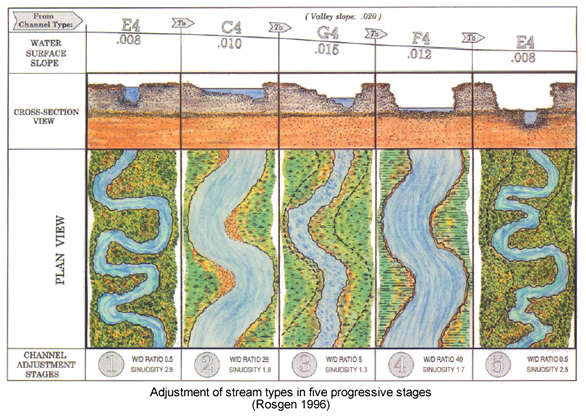
| glossary | menu | Normal | lg | hc | 8.) Rosgen Classification of Stability and Change > Channel Evolution & Return |
| < Previous | 1 | 2 | 3 | 4 | 5 | 6 | 7 | 8 | 9 | 10 | 11 | 12 | 13 | 14 | 15 | 16 | 17 | 18 | 19 | 20 | 21 | 22 | 23 | Next > |
Channel Evolution & Return

In this image, an E4 channel might depart due to watershed development, riparian vegetation removal, or other causes of bank failure. This results in an increase of width to depth ratio, chute cutoff of point bars, and increased slope at C4 level. From there, slope continues to increase, down cutting occurs, width to depth ratio lowers and a G4 channel results. From there, the banks collapse and the channel widens, moving to a F4. The Channel Slope is out of balance with the Floodplain, and the Sinuosity increases, with formation of point bars and vegetation establishment within the F4 channel to reform an E4 at the new base level.
Moving from E4 to F4 decreases sediment transport due to an increased boundary shear stress distribution and less Stream power. While the slope is lower in the E4/C4, they have greater power due to a greater ratio of cross-sectional area to channel wetted perimeter.
Image courtesy of Rosgen
| < Previous | 1 | 2 | 3 | 4 | 5 | 6 | 7 | 8 | 9 | 10 | 11 | 12 | 13 | 14 | 15 | 16 | 17 | 18 | 19 | 20 | 21 | 22 | 23 | Next > |